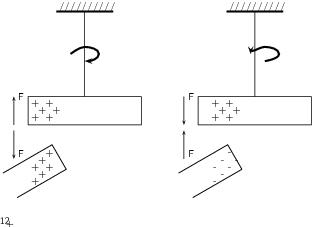| << Chapter < Page | Chapter >> Page > |
The force exerted by non-moving (static) charges on each other is called the electrostatic force. The electrostatic force between:
In other words, like charges repel each other while opposite charges attract each other. This is different to the gravitational force which is only attractive.

The closer together the charges are, the stronger the electrostatic force between them.

You can easily test that like charges repel and unlike charges attract each other by doing a verysimple experiment.
Take a glass rod and rub it with a piece of silk, then hang it from its middle with a piece string so that it is free to move. If you then bring another glass rod which you have also charged in the same way next to it, you will see the rodon the string turn away from the rod in your hand i.e. it is repelled . If, however, you take a plastic rod, rub it with a piece of fur and then bring it close to the rod on thestring, you will see the rod on the string turn towards the rod in your hand i.e. it is attracted .

This happens because when you rub the glass with silk, tiny amounts of negative charge are transferred from the glassonto the silk, which causes the glass to have less negative charge than positive charge, making it positively charged . When you rub the plastic rod with the fur, you transfer tiny amounts ofnegative charge onto the rod and so it has more negative charge than positive charge on it, making it negatively charged .
Two charged metal spheres hang from strings and are free to move as shown in the picture below. The right hand sphere is positively charged. The charge on the left hand sphere is unknown.

The left sphere is now brought close to the right sphere.
In the first case, we have a sphere with positive charge which is attracting the left charged sphere. We need to find the charge on the left sphere.
We are dealing with electrostatic forces between charged objects. Therefore, we know that like charges repel each other and opposite charges attract each other.
The electrostatic force determines the arrangement of charge on the surface of conductors. This is possible because charges can move inside a conductive material. When we placea charge on a spherical conductor the repulsive forces between the individual like charges cause them to spread uniformly over thesurface of the sphere. However, for conductors with non-regular shapes, there is a concentration of charge near the point or pointsof the object. Notice in [link] that we show a concentration of charge with more or + signs, while we represent uniformly spread charges with uniformly spaced or + signs.

This collection of charge can actually allow charge to leak off the conductor if the point is sharp enough. It is for this reasonthat buildings often have a lightning rod on the roof to remove any charge the building has collected. This minimises thepossibility of the building being struck by lightning. This “spreading out” of charge would not occur if we were to placethe charge on an insulator since charge cannot move in insulators.

Notification Switch
Would you like to follow the 'Siyavula textbooks: grade 10 physical science' conversation and receive update notifications?